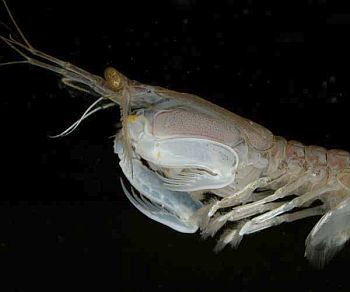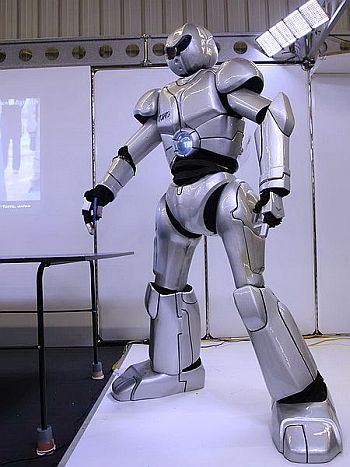Photographs: Wikimedia Commons
Rediff.com brings you the latest in science, medicine, technology and oddities from around the world. Click on subsequent slides for more...
A new study by researchers from the University of Bristol, UK, has determined that the remarkable eyes of mantis shrimps could inspire the next generation of DVD and CD players.
Part 1: Why mosquitos like to bite humans
The mantis shrimps in the study are found on the Great Barrier Reef in Australia and have the most complex vision systems known to science. They can see in 12 colours and can distinguish between different forms of polarised light.
Special light-sensitive cells in mantis shrimp eyes act as quarter-wave plates, which can rotate the plane of the oscillations (the polarisation) of a light wave as it travels through it.
This capability makes it possible for mantis shrimps to convert linearly polarised light to circularly polarized light and vice versa. Manmade quarter-wave plates perform this essential function in CD and DVD players and in circular polarizing filters for cameras.
According to Dr Nicholas Roberts, lead researcher, "Our work reveals for the first time the unique design and mechanism of the quarter-wave plate in the mantis shrimp's eye. It really is exceptional -- out-performing anything we humans have so far been able to create."
"It could help us make better optical devices in the future using liquid crystals that have been chemically engineered to mimic the properties of the cells in the mantis shrimp's eye," he further added.Surgery best cure for migraine
Image: A reproduction of George Cruikshank's The Head Ache. (For illustrative purposes only)A new American study strongly suggests that surgery may be the best option for acute migraine headaches.
The researchers of the University Hospitals Case Medical Centre closely monitored 79 migraine patients after surgery and detection of 'trigger sites' for nearly five years to come up with their findings.
Only 10 of the 79 patients had to undergo additional surgeries for migraine treatment. These patients were removed from the final study. Out of the remaining 69 migraine sufferers 61 showed positive changes post-surgery.
About 29 per cent (20 patients) were cured entirely and nearly 60 per cent (41 patients) showed slight improvement. Eleven per cent (8 patients) showed no improvements.
Bahman Guyuron, MD, Chairman of Plastic Surgery at University Hospitals Case Medical Centre and Case Western Reserve University School of Medicine, said: "Migraine headaches are extremely disabling and this surgical option offers hope for migraine sufferers. Combined with the previous studies, this new five-year data has provided strong evidence that severe migraine headaches and their painful symptoms can be successfully treated with surgery with lasting results."
Pig poop power
Image: A domestic sow and her pigletIn an analysis, a team of scientists has come up with ways to use pig manure to generate electricity.
A large amount of pig manure created by thousands of animals in giant hog farms can pollute rivers, poison groundwater and pump out clouds of methane and carbon dioxide. So, finding alternative uses for the slurry -- to generate electricity, makes a lot of sense.
The problem was that no one has been certain which way of doing it makes the most electricity for the least greenhouse gas production.
Now, according to a report in New Scientist, a Danish team has analysed the various ways in which firms in that country treat pig manure and use it to generate electricity in systems such as anaerobic digesters or incinerators.
In anaerobic digestion, bacteria break down waste material by warming it in an oxygen-free vessel, releasing methane, which is used in gas turbines. Incinerators burn material to boil water and drive a steam turbine.
The team, led by Trakarn Prapaspongsa at Aalborg University, found that for high-efficiency energy production, anaerobic digestion is the answer to convert pig poop into 'green' power.
But if a minimising greenhouse gas emission takes priority, the best option was to separate the solid from the liquid waste, dry the solids and incinerate them.
Men and women have similar stroke symptoms
Image: An artist's impressionSymptoms of heart attack in women are not very different from those in men, according to a new study.
The research was presented to the Canadian Cardiovascular Congress 2009, co-hosted by the Heart and Stroke Foundation and the Canadian Cardiovascular Society.
Cardiac nurse Martha Mackay, a Canadian Institutes of Health Research clinical research fellow and doctoral student at the UBC School of Nursing and her team found there were no gender differences in rates of chest discomfort or other 'typical' symptoms such as arm discomfort, shortness of breath, sweating, nausea, indigestion-like symptoms, and clammy skin.
She said: "Both the media and some patient educational materials frequently suggest that women experience symptoms of a heart attack very differently from men. These findings suggest that this is simply not the case."
The study found that while both women and men may experience typical or non-typical symptoms the major difference was that female patients were more likely to have both the classic symptoms of heart attack plus throat, jaw, and neck discomfort.
Music training can boost memory
Image: Music can significantly enhance human brain's ability to distinguish between various soundsListening to music can significantly enhance human brain's ability to distinguish between various sounds, say researchers.
While analysing brain's electrical and magnetic signals, lead researcher Laurel Trainor, from McMaster University in West Hamilton, Ontario found that those with some training showed larger brain responses on a number of sound recognition tests given to the children.
The study also showed that even a year or two of music training leads to enhanced levels of memory, attention and executive control.
"We therefore hypothesize that musical training affects attention and memory, which provides a mechanism whereby musical training might lead to better learning across a number of domains," said Trainor.
The reason for this, she suggests, is that the motor and listening skills needed to play an instrument with other people appear to heavily involve attention, memory, and the ability to inhibit actions.
However, merely listening passively to music (the "Mozart effect") does not produce the same changes in attention and memory. Another study led by Antoine Shahin and his colleagues has shown that formal music training strengthens auditory cortex responses.
On average, musical training gives a child the same acoustic responsiveness as someone two to three years older. However, he cautions that these studies do not necessarily show that musical training leads to enhanced IQ or creativity.
Sensitive robots
Image: TOPIO, a robot, can play table tennis with humansThanks to research being carried out by Scottish scientists, robots of the future could have fingertips more sensitive than those of humans.
According to a report in The Scotsman, researchers at the Universities of Edinburgh and Sheffield connected artificial mouse whiskers to a robotic brain to gain a better understanding of how the brain processes information relayed by touch.
The scientists found that when objects were brushed against the whiskers, the robot brain learned how to interpret the whisker movement according to its direction, mimicking the function of how a real brain understands touch sensations.
The study could help develop robots with touch sensors as sensitive as fingertips, according to the scientists.
It added evidence to support the theory that the brain learns to understand signals from the senses through experience, and suggests that interpreting touch is not simply instinctive.
"Our findings increase our understanding of how the brain learns how to process tactile information," said Dr James Bednar, of the University of Edinburgh's School of Informatics, who took part in the research.
The researchers believe that robots with sensitive fingertips could be useful for prosthetic limbs or for carrying out intricate work in dangerous environments, such as bomb disposal.







article